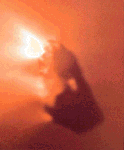
The Giotto mission was designed to study Comet P/Halley, and also studied Comet P/Grigg-Skjellerup during its extended mission. The image at the top of the page is the nucleus of Halley taken by Giotto. The major objectives of the mission were to: (1) obtain color photographs of the nucleus; (2) determine the elemental and isotopic composition of volatile components in the cometary coma, particularly parent molecules; (3) characterize the physical and chemical processes that occur in the cometary atmosphere and ionosphere; (4) determine the elemental and isotopic composition of dust particles; (5) measure the total gas-production rate and dust flux and size/mass distribution and derive the dust-to-gas ratio; and, (6) investigate the macroscopic systems of plasma flows resulting from the cometary-solar wind interaction.
The spacecraft encountered Halley on March 13, 1986, at a distance of 0.89 AU from the sun and 0.98 AU from the Earth and an angle of 107 degrees from the comet-sun line. The goal was to come within 500 km of Halley's comet at closest encounter. The actual closest approach was measured at 596 km. The spacecraft had a dust shield consisting of a front sheet of aluminum (1 mm thick) and a 12 mm Kevlar near sheet separated by 25 cm, which could withstand impacts of particles up to 0.1 g. The scientific payload was comprised of ten hardware experiments: a narrow-angle camera, three mass spectrometers for neutrals, ions and dust, various dust detectors, a photopolarimeter and a set of plasma experiments. All experiments performed well and returned a wealth of new scientific results, of which perhaps the most important was the clear identification of the cometary nucleus. Fourteen seconds before closest approach, Giotto was hit by a "large" dust particle. The impact caused the spacecraft angular momentum vector to shift 0.9 degrees. Scientific data were received intermittently for the next 32 minutes. Some experiment sensors suffered damage during this 32-minute interval. Other experiments (the camera baffle and deflecting mirror, the dust detector sensors on the front sheet of the bumper shield, and most experiment apertures) were exposed to dust particles regardless of the accident and also suffered damage. Many of the sensors survived the encounter with little or no damage. Questionable or partially damaged sensors included the camera (later proved to not be functional) and one of the plasma analyzers (RPA). Inoperable experiments included the neutral and ion mass spectrometers and one sensor each on the dust detector and the other plasma analyzer (JPA).
During the Giotto extended mission, the spacecraft successfully encountered Comet P/Grigg-Skjellerup on July 10, 1992. The closest approach was approximately 200 km. The heliocentric distance of the spacecraft was 1.01 AU, and the geocentric distance, 1.43 AU at the time of the encounter. The payload was switched-on in the evening of July 9. Eight experiments were operated and provided a surprising wealth of exciting data. The Johnstone Plasma Analyser detected the first presence of cometary ions 600,000 km from the nucleus at 12 hours before the closest approach. The Dust Impact Detectors reported the first impact of a fairly large particle at 15:30:56. Bow shocks/waves and acceleration regions were also detected. After the P/Grigg-Skjellerup encounter operation were terminated on 23 July 1992. Giotto flew by the Earth on 1 July 1999 at a closest approach of about 219,000 km at approximately 02:40 UT (10:40 p.m. EDT, 30 June). The spacecraft was moving at about 3.5 km/sec relative to Earth.
 Detailed information on Giotto
- from the NSSDCA Master Catalog
Detailed information on Giotto
- from the NSSDCA Master Catalog Giotto data from the Halley encounter on CD-ROM
- IHW Volumes 25 and 26
Giotto data from the Halley encounter on CD-ROM
- IHW Volumes 25 and 26 Giotto images of Comet Halley
Giotto images of Comet Halley Giotto position
- generates coordinates for Giotto at any given time
Giotto position
- generates coordinates for Giotto at any given time PDS Small Bodies Node: University of Maryland
PDS Small Bodies Node: University of Maryland Giotto Johnstone Plasma Analyzer page - Mullard Space Science Laboratory
Giotto Johnstone Plasma Analyzer page - Mullard Space Science Laboratory Asteroids and Comets page
Asteroids and Comets page Author/Curator:
Author/Curator: